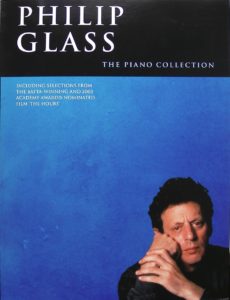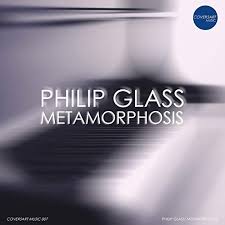Browse in the Library:
Or browse in the categories menus & download the Library Catalog PDF:
Philip Glass – Hymn to the Sun from Akhnaten, with sheet music
Philip Glass’s Akhnaten
On January 6, 1907, the entrance to a rock-cut tomb was uncovered in the Valley of the Kings outside modern-day Luxor, Egypt. The mummy safeguarded within may have been the preserved body of the pharaoh Akhnaten (today more commonly known as Akhenaten).
Rigorous DNA testing conducted in 2010 was reported to have confirmed that identification, though the matter remains hotly contested—like just about everything else associated with this most controversial of ancient Egypt’s vast lineage of rulers.

Why did Philip Glass choose Akhnaten as the topic for his third opera—a figure so distant in time from the protagonists of his first two operas and so obscure in comparison to them? He started from the premise of wanting to complete a trilogy of “portrait” operas about historical figures whose vision and ideas—in contrast to the violent power of warfare—had effected radical social change and transformed our understanding of the world.
The first two installments of the trilogy, Einstein on the Beach (1976) and Satyagraha (1980), had focused on well-known figures who left their respective marks principally in the areas of science (Albert Einstein’s revolutionary theory of relativity) and politics (Mahatma Gandhi and his advocacy of non-violent resistance in the face of social injustice).
The 14th-century-B.C.E. Egyptian pharaoh seized the composer’s imagination as a fitting counterpart in that he represented the realm of religion and would lend historical perspective to a trilogy whose other two subjects were drawn from the modern era. “We know Akhnaten as a man of ideas and, to me, the entire history of humanity is a history of ideas, of culture,” Glass reflected in his 1987 memoir, Music by Philip Glass.
While he was preparing the groundwork for Akhnaten in the early 1980s, Glass decided to turn the uncertainties and tantalizing gaps in our knowledge about the pharaoh to his theatrical advantage. He traveled to Egypt to gather impressions from relevant archeological sites and visited the Cairo Museum, where the elusive fragments gathered in a room devoted to Akhnaten inspired an epiphany about how to proceed with the work-in-progress.
As Glass recalled it: “It seemed to me, at that moment, that we needed no more story than was already there, that the missing pieces, far from needing to be filled in or explained, actually added to the mystery and beauty of our subject.” With the “mere bits and pieces” relating to the ruler that Glass and his team of collaborators had at their disposal, the essential outlines of the scenario took shape and allowed the composer to form “a highly personal vision” of Akhnaten and his era.

The fact that Akhnaten had even existed lay buried for millennia. In the aftermath of the overthrow depicted in the opera’s final scenes, the pharaoh was violently effaced from official history, his revolutionary ideas rejected and revoked. Akhetaten, the new capital city that he founded—which Glass dramatizes in the second act, at the center of the opera—was abandoned and crumbled into ruins. Only with its rediscovery during the archeological expeditions of the 19th century did evidence of the historical Akhnaten emerge, breaking the spell of what Glass calls “a forced amnesia.”
The deliberate suppression of all memory of Akhnaten suggests how radical his challenges to the incredibly conservative social order of ancient Egypt must have been. During his relatively brief, 17-year reign (from 1375 to 1358 B.C.E. in the chronology that the opera uses), longstanding traditions of artistic expression gave way to unprecedented stylistic changes—such as tender, naturalistic depictions of the pharaoh with his wife, Nefertiti, and their daughters.
But the most radical transformation by far was of religious ideology. Within a few years of assuming power, the pharaoh changed his name from Amenhotep IV to Akhnaten to signal allegiance to Aten, an abstract deity associated with the sun god (Ra). He established Aten as the supreme god, overturning the traditional polytheistic hierarchy and disbanding the class of priests whose power derived from rival gods.
According to Shalom Goldman, a professor of religion and ancient languages whom Glass enlisted as a scholarly consultant on this project, Akhnaten’s “rebellion against the massive weight of tradition encompassed religion, statecraft, art, and language; and in each of these areas he attempted revolutionary innovations.”
At the time a graduate student at New York University, Goldman worked with Glass to compile the collage of primary-text sources that make up Akhnaten’s unusual libretto. The chief sources include poem fragments, inscriptions, diplomatic letters inscribed on cuneiform tablets, and legal decrees. These texts are sung in the original ancient languages (Egyptian or Akkadian, the diplomatic language that had developed in Mesopotamia).
A significant exception is the Hymn to the Sun (attributed to the pharaoh himself), which Akhnaten sings in the pivotal final scene of Act II. Glass requests this aria to be sung in the vernacular language of the audience. English is also spoken in this performance by a narrator figure, whose commentary provides translations of the primary-source texts. In the third scene of Act III, with its dramatic time shift to the present, the narrator additionally reads excerpts from a Fodor’s travel guide about the ruins of the ancient city.
And there is a fourth language, which signifies another reason for Glass’s fascination with the figure of Akhnaten: ancient Hebrew, for the choral setting of Psalm 104 sung off stage as a counterpart to the Hymn to the Sun. The psalm’s uncanny echoes of the Egyptian hymn, for Glass, are meant “to underline the connection of Akhnaten’s ideas with those of our own time and culture.”
The composer’s reference is to the controversial theory that Sigmund Freud famously advanced in his 1938 essay collection Moses and Monotheism, that Akhnaten’s suppressed religious revolution survived and re-emerged—channeled by Moses—as ancient Jewish monotheism.
When Glass was in search of a subject for his third “portrait” opera, it was an even more controversial interpretation of the pharaoh’s significance that initially inspired him to consider Akhnaten. A voracious reader, Glass chanced upon a book in which the bestselling “catastrophist” writer Immanuel Velikovsky (1895– 1979) argued that the Greek mythical figure of Oedipus was modeled on actual events from Akhnaten’s life.
In his original concept, Glass contemplated a simultaneous presentation of the stories of Akhnaten and Oedipus (staged upstage and downstage, respectively) and intended to collaborate with Velikovsky as his librettist. But the writer died before they could meet, and Glass soon abandoned his twin-plot concept.
As he writes in Words Without Music, his more recent memoir, Akhnaten “became much more interesting than Oedipus. We think of the ancient world as Greece, but the ancient world was really Egypt.” Rereading Freud’s book “convinced me that Akhnaten was the person I was looking for.”
Akhnaten originated as a commission from Stuttgart Opera, and because the 1984 world premiere would take place while the company’s main house was being renovated, Glass’s orchestral forces would need to fit in a smaller pit space. He decided to downsize by doing without the entire violin section. Still, Akhnaten’s sound world, while unquestionably in its composer’s unique voice, is overall closer than its two predecessors to more conventional operatic scoring. (Einstein was written for non-operatically trained voices and Glass’s own amplified ensemble, while Satyagraha’s orchestra was limited to woodwinds and strings).
Glass made a virtue of the lack of violins by drawing out the darker colors that result. The inventive use of percussion (timpani omitted, also for space reasons) and combinations of wind and brass moreover allow for richly contrasted textures. A striking example that carries symbolic weight for the opera’s dramatic ideas is the juxtaposition of aggressive, militaristic drumming during the funeral ceremonies for Amenhotep III—the sound of the “old order” that his son dares to subvert—with the sonorities associated with Akhnaten, such as the solo trumpet or, in his beautiful duet with Nefertiti, a pair of solo celli.
The composer’s instincts as a musical dramatist are particularly effective in Akhnaten’s vocal casting. How to represent a figure “so unusual, even unique, as to be virtually unprecedented in Egyptian, and therefore human, history”? Glass opted to cast the pharaoh as a countertenor (one of several neo-Baroque touches to this score).
While the renaissance of interest in the countertenor voice has made it much more familiar than it was when Glass initially wrote this music in the early 1980s, Akhnaten’s singing retains a startling effect—at least initially—since he is a silent visual presence onstage until well into the first act. Glass writes Nefertiti as a contralto to be closer in range to her spouse and makes his mother, Queen Tye, a soprano.
The opera’s tonal palette and use of thematic devices identified with characters or actions mark a departure from Glass’s earlier practice. His experiments with polytonality (presenting more than one key at the same time, creating multiple harmonic centers of gravity) impart a greater feeling of ambiguity.
The composer has compared the perception of ambivalence that results from his harmonic language to the kind of optical illusion associated with the paintings of Josef Albers, “where you could look at it two ways, but not both ways at once; it can’t resolve itself.” Akhnaten, he adds, “was my first extension out of a triadic harmonic language that had been fairly simple up until then.”
Akhnaten’s Hymn to the Sun provides a moment of radiant A major at the center, but the looming presence of A minor—the key in which the opera begins and ends—“stretch[es] over the score, and over the theater, like a shroud,” to quote the Village Voice critic Leighton Kerner. At the end of Akhnaten, Glass quotes a thematic cell from the very beginning of the Portrait Trilogy—the opening scene of Einstein on the Beach—but there is no sense of a “return” to where we began.
In Michael Blackwood’s 1985 documentary on the making of Akhnaten (A Composer’s Notes: Philip Glass and the Making of an Opera, which is available on YouTube), the composer reiterated the relevance of this ancient tragedy for our situation: “There’s nothing in the story that isn’t contemporary, really; it’s about power, and upholding old ideas, and trying to force new ideas into the world, and what happens to the people that do that.”
Read the full article here.
Browse in the Library:
Or browse in the categories menus & download the Library Catalog PDF:
